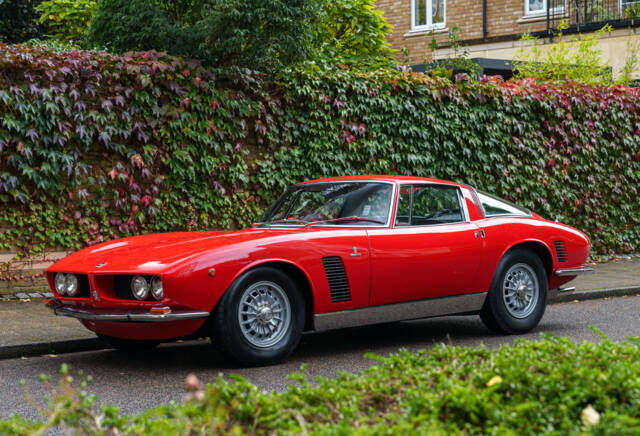ISO Grifo classic cars for sale
The ISO Grifo blends Italian artistry with robust American V8 technology, resulting in a Gran Turismo that redefined luxury and performance from the mid-1960s to the early 1970s. With its striking design by Giorgetto Giugiaro and technical input from engineering legend Giotto Bizzarrini, the Grifo set a benchmark for style and speed in its era.
Search results

1968 | ISO Grifo GL 300
1966 ISO Grifo GL 300
History of the ISO Grifo
The ISO Grifo was the flagship model of ISO Autoveicoli S.p.A., originally a manufacturer of household appliances and compact vehicles. In the early 1960s, Renzo Rivolta sought to enter the luxury Grand Touring market. He teamed up with engineering visionary Giotto Bizzarrini and designer Giorgetto Giugiaro at Bertone to create a car that would rival the best from Ferrari and Maserati, but distinguish itself with American V8 powerplants for reliability and accessibility. The Grifo debuted as a prototype at the 1963 Turin Motor Show, first in the street-oriented A3/L and then as a race-oriented A3/C. Series production began in 1965, enjoying critical acclaim for its combination of Italian craftsmanship and muscular American engineering. Production continued until 1974, when the company succumbed to the economic challenges of the oil crisis.
Model History
The Grifo’s evolution included several variants: the initial A3/L for the road, followed by the lighter, competition-focussed A3/C, which gained recognition for its class win at Le Mans. The Series I (1965–1970) relied mainly on Chevrolet’s 5.4-litre V8 engines, available with a BorgWarner four-speed manual, while later updates introduced the larger 5.7- and 7.0-litre options. The 1970 facelift ushered in Series II, visually noted for pop-up headlights and subtle bodywork tweaks. Low production numbers across all variants ensure exclusivity: approximately 330 Series I cars, even fewer Series II, and rare special editions like the Can Am and 7-Litri. By 1974, just over 400 examples had been built before ISO’s closure.
Highlights of the ISO Grifo
The Grifo’s high point lies at the intersection of Italian style and robust American power. The car’s elegant Bertone lines, combined with a powerful V8 from Chevrolet or, later, Ford, granted it a unique position among GT cars of the era. Notable features included Campagnolo alloy wheels, Koni shocks, differential gearing options, and a luxurious interior loaded with leather, wood, and Veglia-Borletti gauges. Series II added hidden headlights and, at the top end, the enormous 7.4-litre Chevy engine in the Can Am variant. Rare Targa versions and right-hand-drive factory cars further add to collectability.
Technical Data
Special Editions and Collectible Models
The Grifo 7-Litri was launched in 1968, powered by the 7.0-litre Chevrolet 427 engine, necessitating a distinctive Penthouse bonnet bulge. Just a handful of these high-performance models were built, with only four 7-Litri Series II known. The Can Am (IR 9) used an even larger 7.4-litre engine, coupled with the ZF five-speed. The Targa-top Grifo, with just 17 produced, and the rare right-hand-drive builds add further allure for collectors.
Weak Spots and Common Issues
Grifo ownership is simplified somewhat by the use of American drivetrain components, making engine and transmission service far more straightforward than other Italian contemporaries. However, the large big-block models, especially those with the 7-Litri engine, can suffer from heat management issues, leading to potential engine overheating and mechanical wear. Rust can affect steel bodywork, and sourcing specific trim parts—particularly Series II elements like pop-up headlights—may prove challenging due to low production numbers.
Engine and Performance, Transmission and Handling
Grifos deliver formidable straight-line performance, with early 5.4-litre variants offering up to 395 PS and top speeds around 247 km/h. Bigger-engined models, such as the 7-Litri and Can Am, pushed output to 406 and 395 PS respectively, claiming speeds near or above 300 km/h. The chassis, developed under Bizzarrini, featured a well-balanced, rear-wheel-drive setup with independent suspension and precise steering, providing confident handling for a GT of this class. The combination of Koni shocks, powerful disc brakes, and a rigid structure ensures high-speed stability, while the use of standard American parts lends reliability and ease of long-distance travel. The Grifo 7-Litri and Can Am stand out as the pinnacle in terms of raw performance. The original Series I Grifo, with its balanced 5.4-litre V8 and timeless lines, remains highly regarded for driving experience.
Interior, Comfort, Exterior and Design
Styled by Giorgetto Giugiaro at Bertone, the Grifo boasts bold proportions with muscular haunches, crisp lines, and a low, wide stance. Series II models are distinguished by hidden headlights and subtle body shaping. Interiors are richly appointed with leather seats, a wood-veneer dashboard, and clear Veglia-Borletti instruments. Many cars came equipped with air conditioning, electric windows, and AM/FM radios. Options included Campagnolo alloy wheels, special paint colours, and accessories like tool rolls and manuals. Rare models incorporated special materials such as aluminium oil pans or magnesium components on racing variants. Targa tops and right-hand-drive configurations add to the broad scope of Grifo individuality.
Other Notable Features
Some Grifo models used fibreglass body panels, notably for lightweight racing variants. Factory supply of extensive documentation, toolkits, and even replacement seats were a hallmark of ISO’s approach to customer delivery. Unique features like Sabelt harnesses and FIA-approved fuel tanks on A3/C models link the Grifo to its motorsport heritage.
Summary
The ISO Grifo stands as a rare fusion of Italian engineering flair and American mechanical muscle, built in strictly limited numbers between 1965 and 1974. Renowned for its luxury, powerful V8 engines, and distinctive design by two of the automotive world’s greats, it remains an exceptional entry in the world of classic GT cars. Practicality is enhanced by robust running gear, while exclusivity is assured by low production volumes and a fascinating development story spanning road and race applications.
